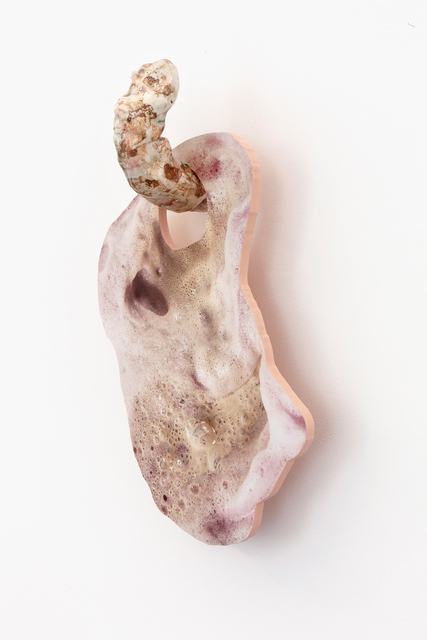Artforum has written an article on the playful materiality of Rachel de Joode’s sculptures in her show Porosity at Galerie Christophe Gaillard.
Rachel de Joode
GALERIE CHRISTOPHE GAILLARD
By Riccardo Venturi, translated from Italian by Marguerite Shaw
Rachel de Joode’s exhibition “Porosity” provided viewers with numerous ways to understand the oscillation between object and photograph, between 3-D and 2-D, between virtual space and physical space that has long characterized her work. In the video Soup, 2015, we see the artist’s hands as she soaks various objects in a whitish and viscous liquid. Shot from above, the comings and goings of, for instance, some bubble wrap, a photograph, or a paintbrush give the screen a sense of depth. Soup shows that everything, even a croissant that floats like a dinghy and resists going under, can become a kind of sculpture—or, more precisely, that everything emerges from a “soup,” a dough, a process of maceration. As the French philosopher Michel Serres has observed, making a distinction between material and mass, statuary takes its basis in the latter. Serres specifies that if material is “an empty metaphysical word, with neither value nor foundation in the physical sciences,” mass, on the other hand, inert and amorphous, “guarantees that a thing exists that is lodged in space, that withstands time and doesn’t care about signs and meaning—radically foreign to our scheming.”
The artist has also taken similar doughy substances—clay, paint, and so on—and modeled them, photographed them, and printed them on two sides of a surface that she then cut out and attached to fourteen stools of different shapes and heights. In these works from the series “Here I am and things that exist. Owl,” 2015, which might be described as faux sculptures, photography is used to deprive the mass of every reference to the figure, to its real dimensions, to its hardness. De Joode’s sculptures sometimes look as malleable as mercury, sometimes as hard as diamonds. They sometimes resemble a soft paste that can be modeled like clay; at other times they resemble a granitelike material that can only be carved. Photography also deprives the mass of any anthropomorphic reference, despite the silhouettes that, from a distance, evoke the sinuous forms of biomorphic sculpture, as their pink color suggests certain skin tones. Only the pink vertical sculptures, here leaning against the wall, refer to the artist’s body, the imprint of which is present in negative.
At this point, does little more remain of sculpture than a digital image? This would be a hasty conclusion, for if photography liberates the mass from its sculptural function, frees it from the heaviness of three-dimensional volume, it does not as a result liberate it from gravity. Moreover, the sculptures rest on pedestals and are not hung on the wall like photographic prints. The artist considers them “things,” and, paraphrasing Heidegger, she states that “the word ‘thing’ names everything that is not simply nothing.” The subtraction of the third dimension, in other words, does not mark a movement toward the immaterial; if these “things” orbit in the space of the gallery, they do so in the manner of celestial bodies or meteorites, and the viewer who circulates in the exhibition space is their witness.
There is a further stage, after the show closes, when the works circulate exclusively online. Today, in our screen-oriented culture, this is how we familiarize ourselves with the work of many artists. Does the artwork once again become a virtual image? The show’s title suggests that the digital interface of the screens does not have the last word. In the continuous interferences between sculpture and photography, between mass and surface, the image becomes porous. There is no paradox here: Just as materiality remains solidly grounded at the heart of digital culture, so too does De Joode demonstrate that porosity does not cease to proliferate.


